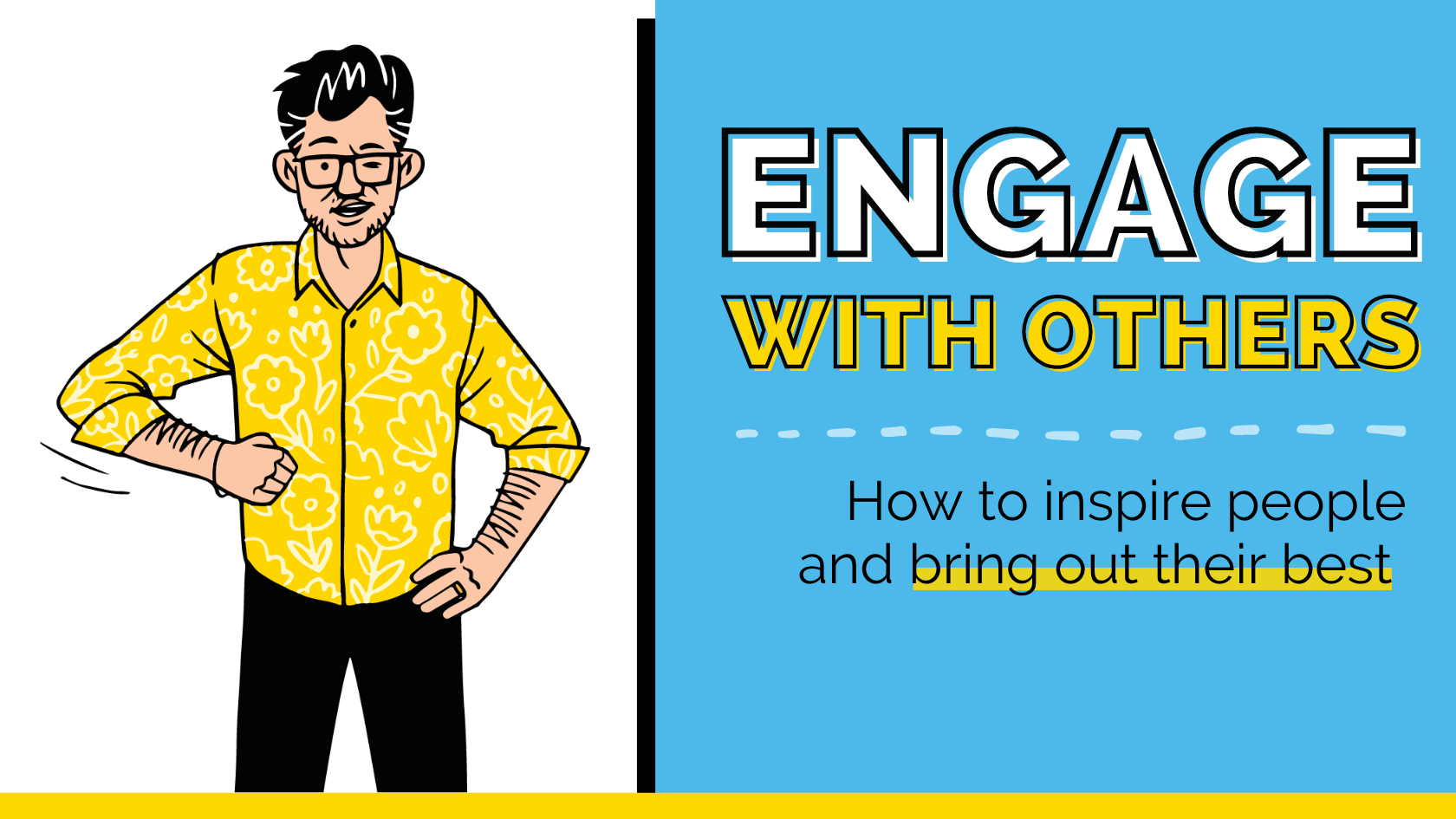“Employee engagement” – it’s one of those phrases that’s so often used, that it’s now almost empty of meaning. It means everything and nothing …
And if it does mean something, it’s not really about connection, motivation, or inspiring people to work better. It’s more of a slippery way of talking about keeping productivity levels high, retaining employees, and 10xing that bottom line.
Whilst acknowledging the need to get things done (the right things, in the right way, at the right time … which is a whole challenge unto itself), I’d love to reconnect “engagement” with “being human”.
Instead of seeing engagement as a tool to lock people in, we should see it as a means to bring out the best in individuals – because that’s what it is.
This kind of engagement makes work meaningful for employees and allows them to express themselves, think big, learn and grow, and connect with challenging goals.
Genuine engagement thrills, daunts, and excites people – it acknowledges who they are and the person they’re striving to become.
Here’s how to create that type of engagement:
1. Create Psychological Safety (And Bravery)
For our workplaces to be appealing, we need to establish relationships that are safe, vital, and repairable.
Let me focus on that first aspect quickly.
Safety refers to psychological safety, where individuals feel safe to show up to be their authentic selves.
And while safety is important, I also think that anyone aspiring to be a manager should create relationships that promote psychological bravery — pushing people to reach their potential and set ambitious goals, while supporting them through any challenges that come up along the way.
It’s not just about creating a warm blanket of safety but fostering an environment where individuals feel supported and challenged. Help the people around you make progress on the things that matter to them, and they’ll want to give it their all.
2. Learn What’s Best for Your Relationship
Understanding the situational context and the position you hold in someone’s life is essential to engagement.
For example, if someone tries to engage with me but only focuses on the soft aspects without challenging me, pushing me, or provoking me, I tend to disengage.
I don’t seek just a comfortable, safe environment – I want to be pushed. In other words, I desire psychological bravery in my relationships.
To find the right balance between psychological bravery and psychological safety with the people you work with, you need to gain an understanding of who you are, who they are, the nature of the relationship, the context, and the seniority dynamics.
I explore this concept in detail in my new book, How to Work with (Almost) Anyone. It’s called the Keystone Conversation, and it’s essentially a framework to help you learn what works best for you and the people around you.
You can do this by asking simple questions like “What are your practices and preferences?” and “How do you like to receive feedback?” to understand how to work together.
3. Embrace Curiosity
If you’ve read my stuff for any amount of time no matter how transient, you’ll know I harp on about curiosity a lot.
I’ve beat that proverbial horse to death, but Shannon Minifie, the CEO of Box of Crayons (the company I founded), has started talking about a new type of curiosity — what she calls “often curious.”
Typically, when we channel curiosity, we’re focused on closing our own knowledge gaps, asking questions like “How do I get from here to here?” or “What’s the answer to that?”
But often curiosity is all about serving another person: seeking to understand their experiences, helping them explore what’s happening in their lives, and encouraging self-discovery.
By bringing curiosity to our conversations and genuinely paying attention to people’s responses, we create an environment that encourages others to open up and share their insights – and that’s exactly what boosts engagement.
Next time you speak with a colleague, try this question from the Coaching Habit: “And what else?”
It’s a powerful tool for improving communication and sustaining curiosity.
4. Practice Fierce Love
I’m a huge fan of Martin Buber’s I-It-I-Thou model, which explores the nature of our relationships with others.
The “I-it” part refers to a type of relationship that is more transactional and focused on getting things done. As a consequence, it often fails to see the human behind the task at hand.
On the other hand, the “I-thou” relationship is all about active and authentic engagement, where both individuals truly show up for each other.
I call this type of relationship “fierce love.” It might sound exaggerated, but it conveys my desire to champion the best version of individuals—both who they are now and who they aspire to be in the future.
“Fierce” reminds me not to get too comfortable in the conversations I’m having. To push myself to be as bold, as courageous, and as vulnerable as I can.
“Love” reminds me that I want to fully champion that person and help them on the journey to be the best version of themselves that they can be, regardless of what we’re working on.
If you can be generous with fierce love at work—wholeheartedly supporting your team, motivating them externally, pushing them, and setting boundaries—you’ll lay an excellent foundation for building workplace relationships that stand the test of time.
5. Let People Know That They’re Seen and Heard
Empathy is another great way to improve your relationships and boost engagement, but the definition often gets confused.
Many people think empathy means to feel sorry for someone – but that’s sympathy.
Empathy is about helping people feel seen, heard, and understood. It’s about showing the person that you can relate to whatever they’re going through.
Often, people do this by sharing their own personal experiences, to show that they relate to whatever the speaker is saying.
The thing is, that doesn’t make the person you’re speaking with feel seen – it actually diverts the attention away from their story.
Saying things like, “That reminds me of something I went through…” can actually undermine your efforts because it shifts the attention back to you.
Showing empathy is actually really simple – it just requires presence. Simply being there, without saying much or trying to fix things, can make all the difference.
You can demonstrate this by saying things like, “I understand,” “That sounds difficult,” or “I can’t imagine what you went through.”
This shows that you’re acknowledging the hardship the other person has faced, even if you can’t fully understand it yourself.
Better Relationships Are the Rocket Fuel for Better Engagement
Ultimately, engagement is not just about controlling people but rather about bringing out the best in them.
To do this, we need to build safe, vital, and repairable relationships while challenging people and promoting psychological bravery. And we need to provide work that has meaning and is the “arena” in which these relationships can flourish and thrive.
As important as relationships are, it’s good to remember that they’re the conduit through which great work gets done. While focusing on building rock-solid relationships is important, it’s also about doing the work (and making progress on it) that challenges, provokes, and serves the world.
It’s a delicate balance – we need to be clear and kind, positive and encouraging but also speak to what’s not working.
If you’d like to learn more about building the best possible working relationships, check out my new book, How to Work With (Almost) Anyone.
Get your copy here!
